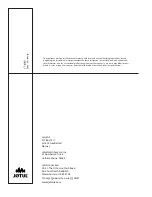
12
138783_Rev_2 1/2/13
User Information
General
Assembly, installation, maintenance and gas conversion
(if required) must be performed by a qualified person in
accordance with the instructions for assembly, Installa-
tion and use enclosed with the product. The installation
may only be operated after it has been inspected by a
qualified person and a certificate of completion has been
issued.
The Installation should be carried out in accordance
with the Building Regulations which include the follow-
ing standards for installation and maintenance of flues,
ventilation and installation of Gas Fires. For UK BS5440:1,
BS5440:2, BS5871 for Republic of Ireland IS813, ICP3, IS327
This appliance incorporates a spillage monitoring
device (TTB) this device will shutdown the appliance in
the event of interruption to the evacuation of combustion
products. I.e. Flue blockage.
If the appliance spillage monitoring device (TTB)
shuts down the appliance repeatedly the appliance
should not be used and a qualified service engineer
should be called for service.
The ceramic fuel effect should only be arranged by
qualified service engineer and under no circumstances
should extra elements be added to the fuel effect. I.e.
Extra logs or Coals
The appliance should be serviced annually by a quali-
fied service engineer and should include attention to the
appliance, installation pipe work and the inspection and
cleaning if required of the flue system.
The minimum clearance to combustible material in
front of the appliance is 600 mm.
Curtains may not be placed within 600 mm above
the appliance.
A combustible shelf may not be placed over the appli-
ance if it is within 520 mm
This appliance becomes hot in use so it advisable to
keep young children, the aged or infirm and animals at a
safe distance using a fireguard conforming to BS6539 or
BS6778 to provide extra protection.
Operating Instructions
Lighting
Note! Odors when using the stove:
When used for the first time, the appliance may emit
an irritating gas that may smell a little. The gas is not
toxic, but the room should be thoroughly aired out. During
first time use, it may take a little while before the gas tube
is cleared of air, but subsequently the appliance should
function as described in the lighting instruction. The ap-
pliance operates with the aid of a pilot flame, which is lit
manually according to the lighting instruction.
Prior to lighting:
Check the area around the appliance for possible gas
leaks/odors. Especially check near the floor, since propane
is heavier than air and would gather close to the floor in
the event of a leakage. (Note: Natural gas is lighter than
air and will gather under the ceiling). If you detect an odor
of gas, see warning under: Safety precautions.
Only use your hands to operate the control knobs;
do not use tools. If you are unable to turn or push in the
control knob, do not use force. Call for service.
Do not use the appliance if any part of it has been
submerged in water. Call for service to replace the parts
that have been in water.
Lighting Instructions
Lighting the Pilot Flame
The valve control knobs are located on the front of the ap-
pliance behind the control cover plate. See fig. 20.
The Burner ON/OFF switch is located on the rear on the
left towards the top of the appliance. See fig. 21. This
switch has three settings ON/OFF/STAT the STAT position
is for use of a remote control thermostat, not available at
present, and this setting should not be used.
1. Place the ON/OFF switch to “OFF” position. Make sure
the gas valve on the pipeline to the appliance is open.
2. Push in the gas control knob on the front of the valve
(“B”, fig. 20) a little, and turn clockwise to “OFF”. Note:
It is impossible to turn the gas control knob unless it is
pushed in a little. Do not use force.
3. Push in the gas control knob (B) a little and turn
counter-clockwise to “PILOT”.






































